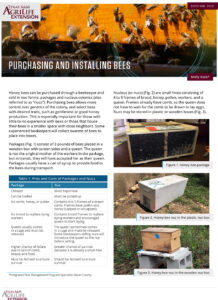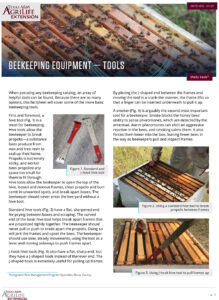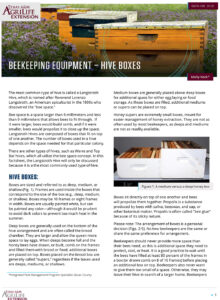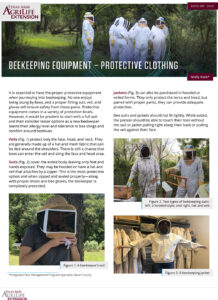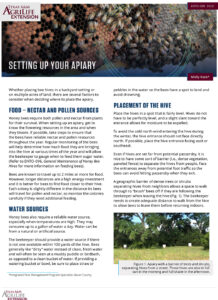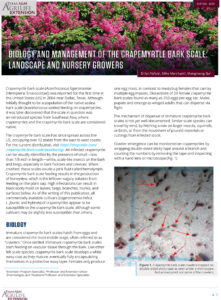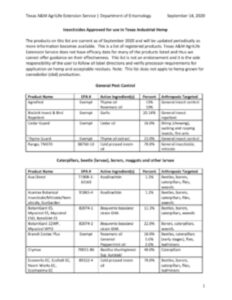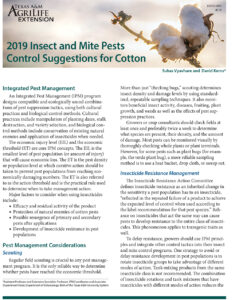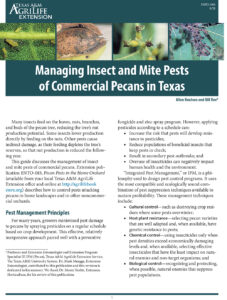Honey bees can be purchased through a beekeeper and sold in two forms: packages and nucleus colonies (also referred to as “nucs”). Purchasing bees allows more control over genetics of the colony, and select bees with desired traits, such as gentleness or good honey production. This is especially important for those with little to no experience with bees or those that house their bees in a smaller space with close neighbors. Some experienced beekeepers will collect swarms of bees to place into boxes.
When perusing any beekeeping catalog, an array of helpful tools can be found. Because there are so many options, this factsheet will cover some of the more basic beekeeping tools. First and foremost, a hive tool (Fig. 1) is a must for beekeeping. Hive tools allow the beekeeper to break propolis—a substance bees produce from wax and tree resin to seal up their home.
Most experienced beekeepers and apiculturists agree there are two reasons honey bee colonies fail: (1) failure to monitor and treat for Varroa mites; and (2) failure to feed starving bees. t is imperative to monitor for Varroa mites regularly. When mite numbers become too high, colonies die. There are many resources available with information on how to monitor Varroa mites and interpret results.
The most common type of hive is called a Langstroth Hive, which is named after Reverend Lorenzo Langstroth, an American apiculturist in the 1800s who discovered the “bee space.” Bee space is a space larger than 6 millimeters and less than 9 millimeters that allows bees to fit through. If it were larger, bees would build comb, and if it were smaller, bees would propolize it to close up the space.
It is essential to have the proper protective equipment when journeying into beekeeping. No one enjoys
being stung by bees, and a proper fitting suit, veil, and gloves will ensure safety from those pains. Protective equipment comes in a variety of protection levels. However, it would be prudent to start with a full suit and then consider lesser options as a new beekeeper learns their allergy level and tolerance to bee stings and comfort around beehives.
Whether placing bee hives in a backyard setting or on multiple acres of land, there are several factors to consider when deciding where to place the apiary. Honey bees require both pollen and nectar from plants for their survival. When setting up an apiary, get to know the flowering resources in the area and when they bloom. If possible, take steps to ensure that
the bees have reliable nectar and pollen resources throughout the year.
Crapemyrtle bark scale (Acanthococcus lagerstromiae [Hemiptera: Eriococcidae]) was reported for the first time in the United States (US) in 2004 near Dallas, Texas. Although initially thought to be a population of the native azalea
bark scale (Acanthococcus azalea) feeding on crapemyrtles, it was later discovered that the scale in question was an introduced species from Southeast Asia, where crapemyrtles and the crapemyrtle bark scale are considered native. This publication covers biology, population dynamics, and management of crapemyrtle bark scale for landscape and nursery grower professionals.
The products on this list are current as of September 2020 and will be updated periodically as more information becomes available. This is a list of registered products. Texas A&M AgriLife Extension Service does not have efficacy data for many of the products listed and thus we cannot offer guidance on their effectiveness. This list is not an endorsement and it is the sole responsibility of the user to follow all label directions and verify processor requirements for application on hemp and acceptable residues. Note: This list does not apply to hemp grown for cannabidiol (cbd) production.
This publication covers control suggestions for thrips, wireworms, cotton fleahoppers, aphids, fall armyworm, bollworm, tobacco budworm, stink bugs, Lygus and verde plant bugs, spider mites, beet armyworm, and whiteflies.
Many insects feed on the leaves, nuts, branches, and buds of the pecan tree, reducing the tree’s nut production potential. Some insects lower production directly by feeding on the nuts. Other pests cause indirect damage, as their feeding depletes the tree’s reserves, so that nut production is reduced the following year.
This guide discusses the management of insect and mite pests of commercial pecans.
